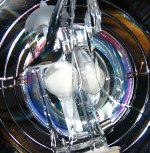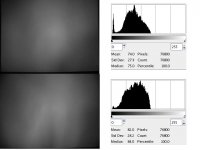Today I made an interesting observation. One can easily boost brightness just slightly shifting the lamp off the reflector center, so the rear fresnel will see the arc twice - one directly, and one reflected, but the reflection must not be covered by the arc tube (like when it's all perfectly centered). Perharps it's only useful with a relatively small lamp, so two arc images shifted apart will still fit into the projection lens, but the difference is very, very noticeable. Haven't made any comparative pictures, and it's hard to judge with an eye only, but I think one can expect about 30-50% more light in the screen. Brightness will not be perfectly even on the whole screen surface, but this irregularity is not visible when watching movies.
My explanations to this trick is what I suspected a long time ago - big metal halide lamps are not very transparent, so when aligned perfectly in the center of the reflector, its semi-opaque arc tube blocks the reflected light.
Here is a picture what it should look when looking from the point of rear fresnel. Don't pay attention to cracked condensor lens, it's not an issue here.
Regards
My explanations to this trick is what I suspected a long time ago - big metal halide lamps are not very transparent, so when aligned perfectly in the center of the reflector, its semi-opaque arc tube blocks the reflected light.
Here is a picture what it should look when looking from the point of rear fresnel. Don't pay attention to cracked condensor lens, it's not an issue here.
Regards
Attachments
what i think in my lack of knowledge opinion is that maybe your actual setup is wrong and what is actually happening is you are capturing the real half result of the almost better aligned setup..what am i talking about well....think about angles etc like i said i dont know much but maybe your actual image would be that bright if not brighter with the twin reflection method, but in a BETTER aligned setup!
personally i hate maths and will do ANYTHING to avoid it. but what screen size are u using power bulb etc man you having said anything. my 250 w 6.5" (pics very soon, top pj) is almost not as bright as a 150w in my ohp setup. why because ohp is optimal design! thanx buddy share more information!!!
personally i hate maths and will do ANYTHING to avoid it. but what screen size are u using power bulb etc man you having said anything. my 250 w 6.5" (pics very soon, top pj) is almost not as bright as a 150w in my ohp setup. why because ohp is optimal design! thanx buddy share more information!!!
No, my actual setup is correct. The explanation is like I said above. Think about the efficiency issue of the spherical reflector: reflected light has to travel back across 4 layers of curved glass, and through the "cloudy" lamp arc. So not much of this reflected light will actually hit the rear fresnel, that's why adding a spherical reflector yields poor, hardly noticeable improvement. But when you shift the lamp a little off the center, so the reflected light will go directly to the rear fresnel, general efficiency will improve, with the expense of having almost doubled arc lenght. So it works assuming your "new" doubled arc still fits the projection lens. Remember that I use a relatively small arc lamp (inner tube is about 2cm diameter). I think real short arc lamp would greatly benefit here, like the lamps from Mr. YWH.
Regards
Regards
Your "theory" is incorrect. The 15 dollar spherical reflector from Lumenlab has shown a 50% increase in light output when measured with a luxmeter. Obviously the light is reflected and travelling through the arc to increase the output.pepe303 said:The explanation is like I said above. Think about the efficiency issue of the spherical reflector: reflected light has to travel back across 4 layers of curved glass, and through the "cloudy" lamp arc. So not much of this reflected light will actually hit the rear fresnel, that's why adding a spherical reflector yields poor, hardly noticeable improvement....
Regards
Obviously, what you measured in those 10$-worth "private forums" is rarely being confirmed anywhere else. Sure, I forgot, it has to be a "pro" reflector 
I've done lots of testing with both steel and glass (OHP) reflectors, also friend of mine has done quite a lot, with a silver plated reflector. No one could get anything more than 20-25% improvement. Search this forum for posts from Guy Grotke, he measured light output, and IIRC he got about 25%, also using a silver-plated reflector.
You can also do a very simple experiment: turn the MH bulb on, take a welding glasses and look at the arc tube. You will see that calling it "transparent" is hardly acceptable. It's semi-opaque and diffusive, and it's very unlikely you will get a significant light increase due to the reflection passing through this stuff, even using a so called "pro" reflector.
Regards
I've done lots of testing with both steel and glass (OHP) reflectors, also friend of mine has done quite a lot, with a silver plated reflector. No one could get anything more than 20-25% improvement. Search this forum for posts from Guy Grotke, he measured light output, and IIRC he got about 25%, also using a silver-plated reflector.
You can also do a very simple experiment: turn the MH bulb on, take a welding glasses and look at the arc tube. You will see that calling it "transparent" is hardly acceptable. It's semi-opaque and diffusive, and it's very unlikely you will get a significant light increase due to the reflection passing through this stuff, even using a so called "pro" reflector.
Regards
pepe303 said:Obviously, what you measured in those 10$-worth "private forums" is rarely being confirmed anywhere else.
Do you have any links to the "anywhere else" that you are referring to?
it's very unlikely you will get a significant light increase due to the reflection passing through this stuff, even using a so called "pro" reflector.
What's unlikely? It's been measured.
OK, did the search for you, free of charge!
http://www.diyaudio.com/forums/showthread.php?s=&postid=803688&highlight=#post803688
http://www.diyaudio.com/forums/showthread.php?s=&postid=803688&highlight=#post803688
Thanks for the link. I'm aware of this thread. This proves there is no comparison between a soup ladle and a true spherical cold mirror coated reflector. The soup ladle was measured with a luxmeter and so was the Lumenlab reflector. The results speak for themselves. No "theory" involved, only the facts.
pepe303 said:Obviously, what you measured in those 10$-worth "private forums" is rarely being confirmed anywhere else. Sure, I forgot, it has to be a "pro" reflector
I've done lots of testing with both steel and glass (OHP) reflectors, also friend of mine has done quite a lot, with a silver plated reflector. No one could get anything more than 20-25% improvement. Search this forum for posts from Guy Grotke, he measured light output, and IIRC he got about 25%, also using a silver-plated reflector.
You can also do a very simple experiment: turn the MH bulb on, take a welding glasses and look at the arc tube. You will see that calling it "transparent" is hardly acceptable. It's semi-opaque and diffusive, and it's very unlikely you will get a significant light increase due to the reflection passing through this stuff, even using a so called "pro" reflector.
Regards
I agree completely. Mikey P if you look at real results by people not trying to make business off of you, most of them claim around a 10 percent increase with spherical reflectors.
Mikey:
You are aware of the thread, but have not read carefully. Guy Grotke was talking about silver-plated reflector. Silver is even better, more reflective than your aluminium plated cold mirror. Cold mirror itself means less efficient mirror, as it "leaks" some light through the glass. That's in case you want to debate such tiny and actually meaningless details.
And I now have a standard, aluminium coated, cold mirror reflector, not a "soup ladle" (which I used too). Same as LL reflector, but a bit smaller. But my lamp is much smaller anyway. Oh man, perharps you assume that information is worth as much as you paid for it. So those news from LL recently lost 50% of its original value, dropped from 20$ to 10$. Here you get information for free, but that actually means invaluable
Instead of questioning everything in this thread, just try it at home, as I'm really interested if anybody confirms that.
Regards
You are aware of the thread, but have not read carefully. Guy Grotke was talking about silver-plated reflector. Silver is even better, more reflective than your aluminium plated cold mirror. Cold mirror itself means less efficient mirror, as it "leaks" some light through the glass. That's in case you want to debate such tiny and actually meaningless details.
And I now have a standard, aluminium coated, cold mirror reflector, not a "soup ladle" (which I used too). Same as LL reflector, but a bit smaller. But my lamp is much smaller anyway. Oh man, perharps you assume that information is worth as much as you paid for it. So those news from LL recently lost 50% of its original value, dropped from 20$ to 10$. Here you get information for free, but that actually means invaluable
Instead of questioning everything in this thread, just try it at home, as I'm really interested if anybody confirms that.
Regards
Hey Pepe, I understand your theory about the arc tube not being so transparent. But if you do what you said, the amount of light reflected by the reflector will reduce since it is no longer in the focus of the reflector. On top of that, the reflected light path will not be in the focus of your fresnel, which further reduces the amount of light that hit the LCD, do you agree?
No offense, but do you think maybe there's a slight chance that what dj_holmes said is possible? meaning your initial setup was not optimal, therefore you are seeing a lot in increase in brightness?
No offense, but do you think maybe there's a slight chance that what dj_holmes said is possible? meaning your initial setup was not optimal, therefore you are seeing a lot in increase in brightness?
I'd like to know why if DIY is so dead, Pepe keeps on putting time and effort into it. Go look up the word Hypocrite . Obviously it isn't dead, and he like all of us, believe there is ability to improve from what we have. The reason a cold mirror works better is simple. It isn't the reflection that we are having problems with. it is the exact direction it is going. That mirror at a certain point is giving the perfect angle, direction and other things that gives it the 50% increase. If you used a silver bowl with exactly the same dimensions, it would probably give you just as much. The problem is, getting the light to go through the fresnels at a desired angle.
Scanboy:
I expect this trick to work only with a relatively small lamp, compared to the rest of the optics. If you have a big lamp, and move the arc off the center, plenty of light will miss the projection lens, and you may not see any improvement. My lamp is small, and I moved it about 1cm, if you look at the light engine, both the lamp arc, and its repositioned reflection will fit the area of a typical 400W arc of a big lamp. In my case there must be more gain due to the unrestricted reflection, than loss due to wrong ray angles.
Miedo:
I'm putting time and effort because I like it. The same with playing the trumpet. And in case anybody asks me for an advice, I still recommend buying a factory projector, it will be cheaper and far better.
Back to the subject, here is a picture of before and after white screen. Seems that there is less gain that I expected, about 12% on the average, but it is noticeable in the screen. The interesting thing is the light distribution, in the second screen you can see that light beam is split into two patches. Instead of a concentrated hotspot in the center, there are two areas of increased brightness, located in two halves of the screen. And if you cut a 16:9 area, the second screen will be brighter with more even light distribution.
Dark shadows are caused by cracked precondensor, it's another issue.
Regards
I expect this trick to work only with a relatively small lamp, compared to the rest of the optics. If you have a big lamp, and move the arc off the center, plenty of light will miss the projection lens, and you may not see any improvement. My lamp is small, and I moved it about 1cm, if you look at the light engine, both the lamp arc, and its repositioned reflection will fit the area of a typical 400W arc of a big lamp. In my case there must be more gain due to the unrestricted reflection, than loss due to wrong ray angles.
Miedo:
I'm putting time and effort because I like it. The same with playing the trumpet. And in case anybody asks me for an advice, I still recommend buying a factory projector, it will be cheaper and far better.
Back to the subject, here is a picture of before and after white screen. Seems that there is less gain that I expected, about 12% on the average, but it is noticeable in the screen. The interesting thing is the light distribution, in the second screen you can see that light beam is split into two patches. Instead of a concentrated hotspot in the center, there are two areas of increased brightness, located in two halves of the screen. And if you cut a 16:9 area, the second screen will be brighter with more even light distribution.
Dark shadows are caused by cracked precondensor, it's another issue.
Regards
Attachments
- Status
- This old topic is closed. If you want to reopen this topic, contact a moderator using the "Report Post" button.
- Home
- General Interest
- Everything Else
- The Moving Image
- DIY Projectors
- increasing brightness



